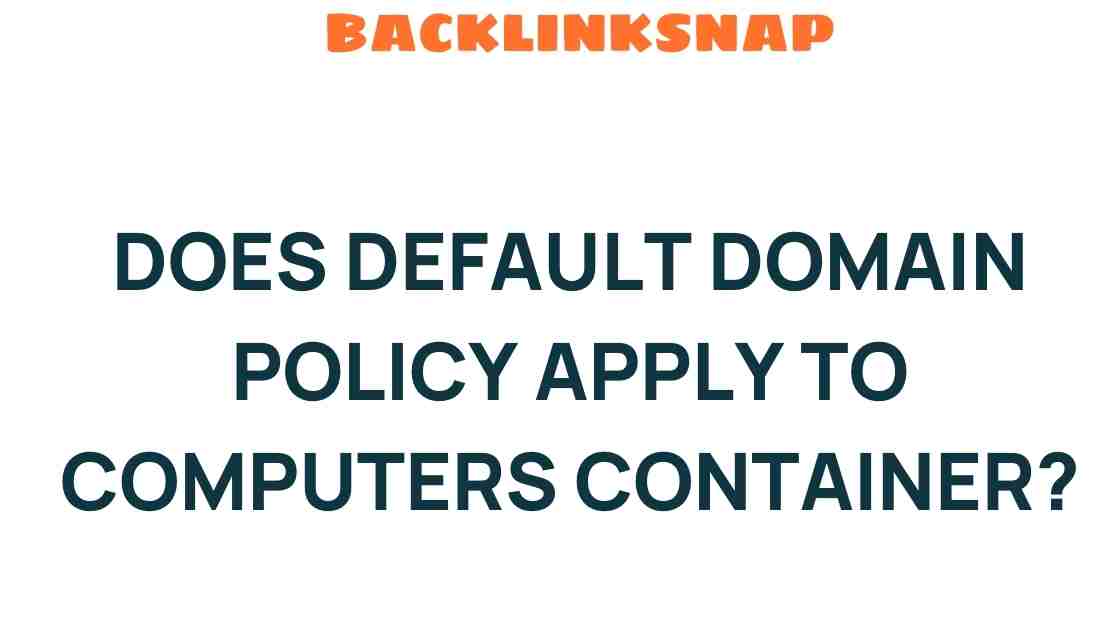Unraveling the Mystery: Does Default Domain Policy Apply to Computers Container?
When it comes to Active Directory (AD) and Group Policy Objects (GPOs), understanding how policies are applied is crucial for IT security and network management. One of the most commonly debated topics is related to the Default Domain Policy and its application to the Computers Container. This article aims to clarify these concepts, delve into the intricacies of policy application, and provide insights based on experience and established best practices.
Understanding Active Directory and Group Policy
Active Directory is a directory service developed by Microsoft for Windows domain networks. It is essential for managing permissions and access to network resources. Within Active Directory, the Group Policy feature allows administrators to implement specific configurations across the network, including security policies, software installations, and user settings.
Group Policy Objects are linked to Active Directory containers, such as sites, domains, and organizational units (OUs). The Default Domain Policy is a GPO that is automatically created in every new Active Directory domain. It is applied at the domain level and typically contains settings that apply to all users and computers within that domain.
What is the Computers Container?
The Computers Container is a default container in Active Directory where newly joined computer accounts are placed. Unlike Organizational Units (OUs), which can be manipulated and structured according to administrative needs, containers are more rigid. They serve as a holding area for objects but do not offer the same level of management flexibility.
Does the Default Domain Policy Apply to the Computers Container?
Yes, the Default Domain Policy does apply to the Computers Container. When a computer account is created in the Computers Container, it inherits the settings defined in the Default Domain Policy. This includes essential security settings, password policies, and user rights assignments that are critical for maintaining IT security.
However, it’s important to note that while the Default Domain Policy applies to computers in this container, specific settings can be overridden by more targeted GPOs applied at the OU level. This flexibility allows administrators to tailor policies to meet specific organizational needs.
Policy Application and Order of Precedence
Understanding how and when policies are applied is vital for effective network management. Group Policy operates on a specific order of precedence, which can be summarized in the following way:
- Local Group Policy: The settings defined on a local machine.
- Site-level GPOs: Policies applied to the site where the computer is located.
- Domain-level GPOs: The Default Domain Policy applies here.
- Organizational Unit-level GPOs: Policies that can override domain policies if the objects are moved into an OU.
This hierarchy means that if a computer is moved from the Computers Container into a specific OU with its own GPOs, those OU policies will take precedence over the Default Domain Policy. Thus, administrators have the power to refine and customize policy application based on their organization’s structure.
Best Practices for Managing Group Policies
Managing Group Policies effectively is essential for maintaining a secure and efficient network environment. Here are some best practices based on experience:
- Minimize the Use of the Default Domain Policy: While the Default Domain Policy is important, it’s wise to avoid cluttering it with too many settings. Instead, create specific GPOs for different needs.
- Utilize Organizational Units: Leverage OUs to apply targeted policies. This allows for more granular control over which users and computers receive specific settings.
- Regularly Review and Document Policies: Conduct regular reviews of the GPOs in place, documenting their purpose and ensuring they align with current security needs.
- Test Policies Before Deployment: Always test new or modified GPOs in a controlled environment before rolling them out to avoid disruptions.
Common FAQs About Default Domain Policy and Computers Container
1. What settings are typically included in the Default Domain Policy?
The Default Domain Policy usually includes settings such as password policies, account lockout policies, and Kerberos settings for authentication.
2. Can I apply different policies to computers in the Computers Container?
Yes, while the Default Domain Policy applies to computers in the Computers Container, you can create and link more specific GPOs at the OU level to override those default settings.
3. How can I check which policies are applied to a specific computer?
You can use the gpresult command in the command prompt to see the effective policies applied to a computer or user.
4. Can the Default Domain Policy be deleted?
No, the Default Domain Policy cannot be deleted, but it can be modified or filtered to limit its impact.
5. What happens if there are conflicting GPOs?
In case of conflicting GPOs, the last policy applied in the order of precedence takes effect. This is where the hierarchy of local, site, domain, and OU GPOs comes into play.
6. Is it advisable to use the Default Domain Policy for all configurations?
It’s generally not advisable to use the Default Domain Policy for all configurations. Keeping it streamlined ensures that it remains effective and manageable.
Conclusion
Understanding the relationship between the Default Domain Policy and the Computers Container is essential for effective Active Directory management. While the default policy applies to all computers in the domain, leveraging organizational units allows for greater flexibility and security tailored to specific needs. By adhering to best practices in policy management, IT professionals can ensure a robust and secure network environment. Always remember that the key to successful network management lies in clear understanding, strategic planning, and continuous improvement.
For more information on Active Directory management, you can visit Microsoft’s official documentation here. Additionally, for deeper insights into Group Policy, check out this resource.
This article is in the category Digital Marketing and created by BacklinkSnap Team




